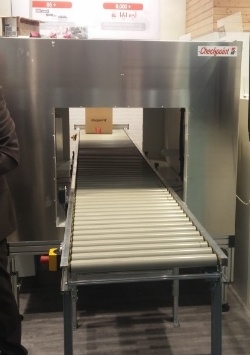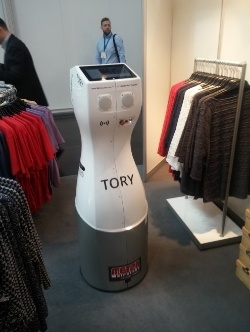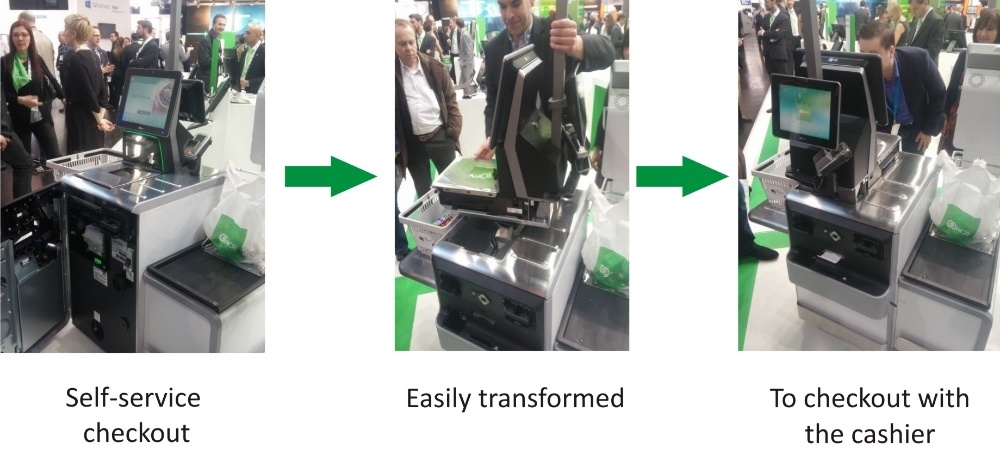Kęstuti’s trendspotting at Euro-CIS
StrongPoint’s Kęstutis Kadelskas wandered the hallways of Euro-CIS recently and collected trends and news along the way. Here is his report.
During the fair you could hear a lot of trendy buzzwords: omni-channel, customer experience, omni-commerce, self-scanning, self-payment and etc. However, I would like to dwell on a few more specific solutions that caught my attention.
Development of electronic shelf labels
First of all – electronic shelf labels. It was one of the most exhibited equipment this year. The reason for such a peak is that electronic shelf labels (ESL) have become colourful. For the last decade it was available only in black and white but this year, the colour palette was supplemented with red and yellow. The appearance of colours established new possibilities – it becomes a lot easier to emphasise the product with discount prices or to get the customer’s attention for other reasons. All that is needed is to turn on a different colour. In the case of black and white ESL, retailers had to use additional plastic colourful accessories – it caused additional expenses and demanded human resources.
System integrators are constantly looking for ways for how to use ESL to give added value for retailers – not just replace paper labels with electronic. One such an example that caught my attention is named FindBox. Its aim is to help customers find suitable ink cartridges, batteries, light bulbs or cell phone accessories. I guess many of us are familiar with the situation of spending a long time at the shelf of ink cartridges or a whole range of screws until you finally manage to find the right one. Or you give up and leave without it. Findbox is a kiosk with image recognition system that is trying to solve such cases. You bring your old ink cartridge, place it in a certain position and the system identifies it. Then, the ESL indicator on the shelf where the item is, starts to blink. According to this solution provider, it has been installed at 300 Mediamarkt stores in Germany.
Application of RFID technology 
One more technology that I would like to mention is RFID. Three or four years ago, this technology was in vogue and a bright future was predicted for it. However, adoption of the solution hasn’t spread on a mass scale. At this moment RFID has taken root at great fashion chains. Its main aim is control of goods movement in the whole supply chain, starting with the factory and ending with the store with intermediate distribution centres in-between. The RFID label is hitched on the item at the factory with all information about the item in it. From this point its movement can be traced and controlled more operatively than using barcodes. Illustrations at the fair showed a RFID tunnel reader that reads and identifies received items in boxes. It accelerates the process significantly as items don’t need to be taken out of the boxes.
Over 100 such tunnels are installed at the fashion retailer Inditex central warehouse in Spain. As Inditex is expanding online, RFID helps to identify if sent items are the ones that the customer ordered. This method creates better customer service and secures the process from dishonest employees. One more way to apply RFID is at grocery chains – for meat, fish and similar products. In order to improve the customer experience RFID labels with the product expiration date is applied on product packages. Finding and separating products where the expiration date has passed using a RFID scanner is several times faster than checking every item manually. This results in improved customer service. According to the manufacturers, this system is now tested by one of Spain’s supermarket chains.
The robot assistant
Here you can see the store of the near future: With a robot. No, it is not an automated store cleaner. This robot’s purpose is to carry out the inventories at clothing stores using RFID technology. It also identifies which items are hanging in the wrong place. The retailer is able to update inventory every night and the orders are maintained in the store and displays meet the planograms.
The latest NCR self-service checkout solution
So, what’s new at self-service? NCR presented the latest self-service checkout solution NCR FastLane SelfServ Release 6. Some of the improvements are designed for customers – improved equipment ergonomics, more convenient and user-friendly interface and faster cash machines. Others improvements are for the retailer – increased system security and protection from dishonest shoppers. Moreover, self-service checkouts become more versatile because it can be transformed – it can function both as self-service as well as in a traditional checkout. Thus retailers can use it even more efficiently depending on customer flow at the store. For example, in the morning, when store has less visitors, the checkout can work as self-service solution, and in the evening during the peak time it can work as checkout served by a cashier.
You can read more about the benefits of self-checkouts in our blog post “The self-checkout paradox – faster or slower?”.

Euro-CIS is an IT technology trade fair for retail that took place in Düsseldorf on February 23-25.
- 411 exhibitors from 29 countries presented their solutions and equipment
- The event counted about 10,400 trade visitors from 87 countries
- This year, the fair had 18% more visitors than in 2015 and it is considered one of the most important events for retail IT technologies in Europe
Do you have the most efficient solutions for your store? Download our guide “7 Steps for a more effective store” and get our tips for greater productivity.
